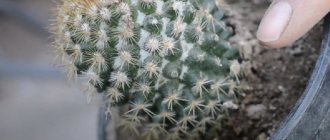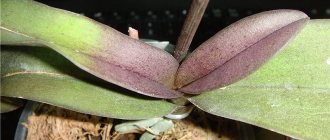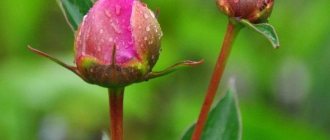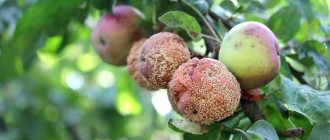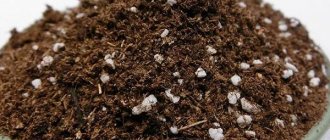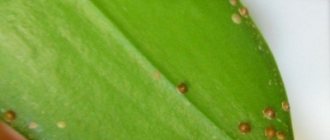Unfortunately, there are many diseases of orchids. Therefore, it is very important to know how they manifest themselves and distinguish between their symptoms. This will help you choose the right treatment method in a timely manner. And knowing the enemy by sight, you can even prevent his appearance.
Representatives of the Orchid family are extremely susceptible to rot, the sources of which can be both fungi and bacteria. Among these diseases, brown rot, black rot, root rot, fusarium rot and gray mold are often found.
Quite often, orchids suffer from diseases, the symptoms of which appear on the leaves. Such diseases also need to be able to distinguish. This may include leaf spot, anthracnose, and powdery mildew.
It also happens that orchids become infected with viral diseases. But, unfortunately, there is no escape from them. In this case, the diseased plant will have to be destroyed.
Brown (bacterial) rot
Phalaenopsis, cattleya, cymbidium and paphiopedilum are most susceptible to this disease.
If light brown and watery spots appear on the shoots and young leaves of the orchid, the plant most likely has brown rot. Over time, the spots may begin to darken, increase in size and merge with each other. Most often, this disease affects young leaves.
The damage process is especially accelerated by abundant watering and low air temperature in the place where the orchid is kept.
If the damage is minimal, the orchid can still be helped. To do this, using a sharp instrument, you need to cut out the affected areas to healthy tissue. Next, the cut areas should be sprinkled with crushed coal and treated with a copper-containing preparation, for example, Bordeaux mixture. After the “surgery,” the orchid should be kept in the conditions indicated for the specific species.
If the damage is too severe, then it is almost impossible to cure an orchid that has become infected with brown rot. No matter how pitiful the plant is, it is best to destroy it before the diseased flower infects the healthy ones.
To prevent brown rot, you can spray the orchid with copper sulfate once a month.
Black rot
The fungus as the cause of this disease most often affects paphiopedilum and cattleya.
This disease usually occurs due to too low a temperature. Orchids are heat-loving plants, and if they are kept in the cold for a long time, they can develop black rot. The disease can also appear on plants that have been weakened as a result of attack by pests or due to existing other diseases.
The affected areas should be removed to healthy tissue with a sterile knife (or scissors), and the affected areas should be treated with charcoal or Bordeaux mixture. After this, the substrate in which the orchid grows must be disposed of, and the pot must be sterilized. When the plant is replanted, it should create conditions favorable for successful restoration.
It is almost impossible to cure an orchid, most of which is affected by black rot - all that remains is to get rid of the plant as soon as possible. But you can save neighboring orchids and other house plants. In the case of black rot, this can be considered a great success. To do this, treat the flowers standing next to the orchid with Bordeaux mixture or some other copper-containing preparation.
The best prevention of many fungal diseases, which include black rot, is to follow all the rules for caring for an orchid.
Signs of defeat
Even slight darkening of the process indicates the seriousness of the problem. Once the disease spreads, it can destroy the entire flower. Due to necrosis of the root system, nutrients do not reach the above-ground part. As a result, the stem and leaves change color and look painful.
Planting in transparent plastic pots makes it easy to diagnose fungal or viral diseases, as well as monitor the condition of the root system and, if necessary, make changes to the bait.
Healthy shoots have a dense structure and are distinguished by a greenish, or less often gray, tint. They are smooth and slightly slippery to the touch. All representatives of the orchid family have very fragile roots, so they need to be checked with extreme caution. You should pay attention to the following signs of damage.
Dots and/or spots
Such symptoms appear most often in the phalaenopsis genus and indicate the development of a fungal infection. The root system is first covered with small dots, which subsequently develop into spots, which in turn form one continuous colony.
The infection subsequently spreads to the above-ground part of the plant. The stem and bases of the leaves become covered with black or brown rot. The result is always the same - the roots of phalaenopsis and the plant itself slowly but surely die if you do not intervene promptly.
Blackening of the base
When the base of the shoots begins to darken and rot, then most likely the flower was overcooled. Orchids grow in the tropics, where the average daily temperature is around +25⁰C. If the thermometer drops below +16⁰С, then the plant and the root system in particular will begin to hurt - turn black and rot.
Root tips darken
A similar reaction can be caused by a chemical burn. It happens that inexperienced gardeners incorrectly calculate the concentration of fertilizers, fertilizing or growth stimulants. The root tips react very sharply to any changes in the substrate.
You need to add fertilizing with an eye to the instructions for the product and the type of orchid. Under no circumstances should you feed the flower uncontrollably. It is best to consult a specialist about a particular drug.
It is impossible to somehow cure chemical burns, only to alleviate the condition of the flower. The best option would be to replant into new soil. But before planting a flower, the roots must be prepared and carefully processed.
Raid
In a good half of cases, plaque appears as a result of damage to the flower by a fungal infection - fusarium. Mold colonies develop well on domesticated subspecies of orchids due to improper care.
Conditions for the spread of fusarium:
- low ground temperature – less than +18⁰С;
- dryness of the substrate and roots;
- the overwhelming percentage of peat in the soil;
- too much salt content in the substrate.
Colonies develop slowly, and in the first stages of infection it is extremely difficult to identify the problem due to the absence of obvious signs. After about six months, redness on the shoots begins to appear, and after another month they turn black and rot.
Root rot
Cymbidium, Miltonia, and Paphiopedilum are more susceptible to root rot than other orchids.
If an orchid is affected by root rot, the leaves of the flower begin to turn brown, and the roots rot and become soft. Too high a temperature and high humidity are often factors that accelerate the development of the disease.
It is worth starting treatment by creating favorable conditions for keeping the orchid, since the disease most often occurs due to violations in care. If an orchid is damaged by root rot, it is necessary to treat the roots and substrate of the plant with a solution of Fitosporin-M or the drug Trichoderma Veride, according to the instructions. To achieve a positive effect, it is advisable to carry out the procedure 3 times with an interval of 10-14 days. The easiest way to carry out the treatment is by immersing the pot in the solution.
When planting an orchid, you should use high-quality disinfected soil - this will be the best prevention of root rot.
Prevention
The first thing that needs to be strictly controlled during the rehabilitation period is watering. The frequency and volume of incoming liquid must be adjusted taking into account the subspecies of orchid. The flower pot must be drained. Otherwise, the water will stagnate and the root will rot and, as a result, turn black.
If the flower is not actively blooming or not resting, then the substrate must be dried regularly. Naturally, you cannot water the plant. It is better to use liquid prepared in advance.
Plain tap water can harm the flower due to the abundance of salts. Plaque will begin to appear on the shoots, which prevents the roots from being enriched with nutrients. Therefore, many experienced gardeners recommend using filtered (through activated carbon) water with the addition of a weak solution of potassium permanganate. The composition should ultimately have a slightly pink tint, but not bright red, which indicates a supersaturation of the liquid with potassium.
Orchids also need to organize an optimal microclimate. Almost all members of the family feel great at a temperature of +25⁰C and a humidity of about 50-70%. In the summer months, as a rule, no problems arise, but in winter the microclimate will have to be adjusted with lamps and other artificial means.
Fusarium rot
Orchids such as phalaenopsis, miltonia, and epidendrum most often suffer from this disease.
This disease also refers to rot and is manifested by yellowing of leaves and the appearance of spots on them. The disease also affects young shoots. The easiest way to identify fusarium is by the leaf blades, which become soft, curl and may become covered with a pinkish coating (fungal spores). If this happens to your orchid, the prognosis is disappointing. The cause of the disease is most often the lack of air circulation in the room and high humidity.
To rid an orchid of fusarium, you need to treat it with Fitosporin-M solution for 10 days, immersing the pot with the plant in it 3 times a day. It is also worthwhile to completely stop spraying for a while, so as not to provoke the rapid development of the disease. It is also recommended to ventilate the room with orchids more often, while avoiding drafts.
The best protection for an orchid from fusarium is compliance with all necessary care rules.
How to restore a damaged orchid
In most cases, a damaged orchid can be revived by stimulating the growth of new roots or leaves. The phalaenopsis orchid has amazing restoration properties when used correctly and following recommendations. If the orchid did not die, but only leaves remained, even in this case you can grow a new healthy and strong plant.
How to revive phalaenopsis without roots
From the neck of a healthy leaf you can grow roots and get a new healthy plant. To do this, you should prepare a special nutrient solution by taking boiled cooled water and adding 1 - 2 tablets of activated carbon to it.
You will also need a drug to stimulate root formation, for example, Kornevin or Epin.
To form roots, you can use the upper living part of the plant, which has a growing point or a healthy leaf. After cutting a cutting or leaf, it must be placed in a dry, warm and shaded place for about 2 hours so that the cut area has time to heal.
After this, the prepared planting material must be placed in a solution of a root formation stimulator for 20 minutes. Next, you need to put an activated carbon tablet into the water, using a small container, and place the prepared cuttings.
To germinate, containers should be placed in a warm place (temperature within 25°C), and provided with sufficient lighting (diffused). The room where the cuttings are located must be regularly ventilated.
The leaves of the plant should be wiped daily with sweet water, diluting 3 teaspoons of sugar in a liter of boiled water.
About once a week, plants need to be sprayed with a special foliar fertilizer. Water must be added if necessary, since the cuttings must be immersed in water by 1 cm. When the length of the young roots reaches 5–7 cm, the young plants can be transplanted into pots. This happens after about 2 months.
How to save a plant after insufficient or overwatering
If a plant does not receive a sufficient amount of water, its roots begin to dry out and its leaves gradually wither, and bringing watering back to normal does not always help. To correct the situation you need to:
- Dilute 1 ml of vitamin B in 1 liter of water and immerse the plant in this solution for about half an hour;
- After this, the plant should be removed, and sphagnum moss should be placed in the remaining solution for about 2 minutes;
- After the time has passed, the moss must be removed, the excess water should be allowed to drain so that the moss remains moist, and it should be placed at the bottom of a plastic bag, preferably with a ziplock, and the diseased orchid should be placed on top of the moss.
- The bag should be tightly closed and left in a shaded place, maintaining a temperature of about 25°C.
It is necessary to ventilate such a greenhouse several times a day for about 30 minutes , making sure that condensation does not evaporate. It usually takes at least a month to recuperate.
Gray rot
Phalaenopsis, cymbidiums and cattleyas, which bloom with white flowers, are susceptible to gray rot.
The presence of gray rot on an orchid is not difficult to determine: it is characterized by dark islands covered with a gray fluffy coating, which can be seen first on the leaves, then on the soil and ultimately on the flowers of the plant. Brown specks on flowers will also indicate the presence of this disease. Gray rot is a consequence of improper orchid care. The reasons for its occurrence are still the same - low temperature in combination with high air humidity. However, excessive application of fertilizers with a high nitrogen content can also cause damage to an orchid by gray rot. A high concentration of this element often leads to plants becoming less resistant to this disease.
If the orchid is severely damaged, the damaged areas should be removed and then the plant should be sprayed with fungicides, for example, Sporobacterin, according to the instructions. At the same time, it is worth noting that if the same orchid is again affected by gray rot, the same drug cannot be used. Fungal spores very quickly develop immunity against fungicidal drugs.
When watering an orchid, you can use special preparations that increase its resistance to disease. Then it will be possible to avoid the appearance of gray rot. And you shouldn’t forget about proper care of orchids either.
When placing orchids in a home flower garden, you should not place them close to each other. If one of the plants gets sick with gray rot, the disease can very quickly spread to neighboring plants.
Reanimation of an orchid after frostbite
If the leaves of an orchid are frostbitten, they become covered with wet spots. With severe frostbite, the leaves quickly turn yellow and die. Damaged leaves feel like slippery jelly to the touch and may become enlarged.
In such a situation, the plant needs urgent help.
However, it is important to remember that the plant can only be saved if there is little frostbite. If the entire plant becomes slippery and soft, it will not be possible to save it. If the leaves of a plant are frozen, they must be removed by carefully cutting them at the tip and slowly stretching them to the sides until the frostbitten leaf is completely removed from the main stem. The trunk in this place should be powdered with charcoal.
If the plant's peduncle is frozen, it must be cut down to the place where the first dormant bud is located, which is not damaged.
If the roots of an orchid are frostbitten, it is very difficult to save it. To do this, you need to carefully trim the damaged roots using a sharp, disinfected sector. After this, powder the sections with charcoal and let them dry.
The condition of the plant must be monitored. If the blackening does not spread along the trunk, you can try to grow new roots. If the blackening spreads, it will not be possible to save the plant.
Leaf spot
The development of this dangerous infectious disease, to which phalaenopsis is most often susceptible, is facilitated by too bright lighting in the spring and summer, improper watering and excessive fertilization. Leaf spotting can be determined by dark, wet spots that appear on weakened orchid leaves.
To save the orchid, you will have to remove all the affected leaves from the plant, and then spray the flower with a fungicidal preparation and not water it for the next 4-5 days.
Anthracnose
Miltonia, oncidium, paphiopedilum, and phalaenopsis are most susceptible to the disease.
This disease most often appears on leaves and sometimes on pseudobulbs. Signs of anthracnose are small and round but distinct brown spots that may enlarge and coalesce over time. Large areas gradually become black and form dents. At a completely advanced stage, a yellowish or pinkish coating may appear on the spots. Most often, an orchid is affected by anthracnose due to too high air humidity, as well as stagnation of water in the axils of the leaves or in the core of the pseudobulbs. The causative agent of the disease is a fungus.
Areas affected by anthracnose should be cut off from the orchid and burned. The cut areas should be treated with activated carbon or ash. Copper-containing preparations, such as HOM or Horus, will help cure an orchid. They need to treat the flower three times with an interval of 10 days. After this, you should reduce watering and stop feeding the plant.
To prevent anthracnose from appearing on an orchid, it needs to be provided with air humidity of 40 to 70%. In addition, it is recommended to periodically ventilate the room with the flower so that the air does not stagnate, but circulates well. In addition, after watering, water from the leaf axils and cores of the pseudobulbs must be removed using a cloth or napkin.
What threats are there?
The orchids in question generally have strong immunity. If it weakens due to the incorrect content of culture, then the emergence of certain problems becomes a matter of time.
Phalaenopsis diseases, photo
Anthracnose a very dangerous fungus that settles mainly on leaves. Small black or dark brown spots form in infected areas. They gradually increase and unite. The tissues die and a yellowish, pink or whitish coating appears on them. Excessive air humidity provokes the disease.
When describing diseases of phalaenopsis with visual photographs, one cannot fail to mention bacterial spotting . This disease also often affects dendrobiums. First the leaves turn yellow, then they turn brown, become soft and crack. Wet ulcerations form on their surface. The disease most often occurs in the second half of spring and summer. It is provoked by both excessive watering and too bright light.
Powdery mildew signals itself with a white coating. It is slightly sticky at first. Specks can appear on both foliage and flowers. The orchid dries quickly and may die. Heat in the house and excessive humidity contribute to the development of the disease.
Rust does not often infect phalaenopsis plants. However, you should know that this fungus is extremely dangerous. In a diseased plant, the leaves are first damaged (sticky spots of a light shade appear there). Then the plates turn red, and a little later spores similar to plaque form. Without treatment, the flower will probably die.
Sooty fungus appears as a result of infection with certain parasites. It forms in the mouths of leaves, which interferes with metabolism. Of course, in the end, if nothing is done, the orchid dies.
Fusarium disease leads to rotting of the flower. The main symptom is curling and yellowing of the leaves. Then they soften and die. At the same time, pinkish spots appear on them. Poor ventilation and high humidity provoke the problem.
Brown bacterial rot mainly spreads along young shoots. Due to the disease, they darken and grow together. Removing rotten areas can save phalaenopsis only in the early stages; in later stages, treatment will not help. The pathology progresses with excessive watering and in the cold.
Heart rot first forms on young stems and foliage. Wet spots appear there - they turn black and expand. Then the infection reaches the roots and the flower dies. A provocateur is high air humidity.
Considering the diseases of phalaenopsis orchids and their treatment, with photos, in the article, it is also worth focusing on viruses. A common symptom is a change in plant shape and color. These diseases do not show their presence for a long time, so the infection often manages to spread throughout the entire culture. The main factor contributing to the development of pathology is the use of unsterilized instruments. There are no effective means of combating viruses.
Pests
A considerable number of parasites threaten phalaenopsis, but most often thrips . The insects are very small (about 2 mm), oval in shape, with black wings. They say about their appearance:
- silvery coating;
- whitish small spots.
Parasites lay eggs directly into the thickness of the leaf. The hatched larvae use the flower tissue as food.
Important: keep newly purchased phalaenopsis in quarantine for at least 15 days - this time is enough to ensure their good health.
The nematode is as tiny as the thrips, but this pest drinks orchid juice. His favorite place is at the base of the roots. This is where the dead areas first appear. Later they spread to the stem and leaves, causing them to dry out. Without treatment, phalaenopsis will die sooner or later.
The mealybug is another insect whose elongated body is covered with a specific white coating. The parasites hide in the mouths of the leaves, the eggs are attached to their back side, and their food is the juice of the flower. The pest is identified by small silver grains that appear in feeding areas.
Spider mites - externally, insects differ in color (found from red to pale gray). But in any case, the parasite settles on the back side of the leaves. This is where he lays his eggs. Since the size of the pest rarely reaches 0.3 mm, it is unrealistic to see it. Signs of infection are light silvery cobwebs and small whitish or, on the contrary, brown spots. The tick feeds on the juice of the orchid, which is why it eventually withers.
Aphids come in different colors:
- green;
- brownish;
- white;
- black;
- yellowish;
- even pink.
It causes the leaves to become deformed and dry out. Their surface often becomes sticky due to honeydew secreted by the pest.
The bulb mite prefers roots - it settles in them and drinks the sap. Eventually they die off. The parasite is light cream in color and up to 1.5 mm long.
The whitefly resembles a small moth - it has elongated wings with longitudinal stripes. The adult size is 1.5 mm. The larvae are white, with red eyes and spines on the body. The leaves of the plant suffer - they turn yellow and then fall off.
The scale insect is an oval parasite with a hard yellowish shell and many short legs. The average size is 2 mm. Outwardly it resembles a tubercle formed on a leaf. The pest drinks the juice and secretes sweet dew.
Podura is also found on orchids . She looks like a small caterpillar. The color of the body varies. Length from 2 to 10 mm.
Woodlice has 14 legs and a scaly shell - grayish or yellow. Size - up to 10 mm. It can eat a flower placed on a shaded balcony.
Powdery mildew
All home orchids are equally susceptible to powdery mildew.
If an orchid is affected by powdery mildew, its leaves and buds become covered with a white coating. The disease causes the damaged areas of the plant to begin to dry out, and soon the flower dies. The development of the disease is promoted by high humidity and high air temperature. Such conditions are also called the greenhouse effect.
Powdery mildew must be combated as soon as its signs are detected on the plant. This will allow you to cure the orchid without significant losses. A solution of colloidal sulfur helps well against powdery mildew. You can also cope with the disease with the help of the drug Baktofit.
In order to prevent powdery mildew, the orchid should be sprayed with Fitosporin-M, according to the instructions.
Pests and their control
Orchids do not get sick out of nowhere. The main cause of flower diseases are pests that have settled on the plant or in the substrate. By injuring the orchid, they allow viruses and fungi to enter the plant through damaged areas.
Various types of mites are considered the most insidious among orchidists . Why? It is very difficult to get rid of these pests, even if you know how to treat them, because... they have four stages of development:
- Egg;
- Larva;
- Nymph;
- Adult.
Stages of spider mite development.
The drugs sold in stores mainly act on adult ticks, which quickly become accustomed to the poison, so it will not be possible to kill them in one go.
There is no need to discount other parasites:
- Mealybug;
- Scale insects and false scale insects;
- Thrips;
- Aphid;
- Nematodes;
- Moths.
The following animals also live in the ground:
- Midges;
- Fungus gnats;
- Root mites;
- Springtails;
- Fools;
- Snails, slugs.
It is in order not to infect home flowers that all new plants must be treated with acaricides and insecticides.
You will find the most detailed information about orchid pests with photos and how to deal with them here.
You will get more information about the most common diseases and pests from this article.
Viral diseases
More often than other genera of orchids, a viral disease can affect cymbidiums, cattleyas, phalaenopsis and vandas.
The last thing you should be afraid of is viral diseases, since they rarely affect orchids. Most often they appear as mosaic spots on leaves and flowers. Also, in case of viral diseases, characteristic spots in the form of circles, stripes or arrows can be seen on domestic “tropicanas”.
Unfortunately, it is not possible to cure an orchid affected by a viral disease. If you suspect that something is wrong with an epiphytic pet, it should be urgently isolated from other plants. If the assumption is confirmed, then the diseased orchid will have to be disposed of.
Forewarned is forearmed. Now you know everything about orchid diseases and, if something happens, you can protect your plants from their silent enemies.
What in a houseplant can be affected?
Orchid diseases most often manifest themselves on:
- Leaves. They can become covered with plaque both from the outside and from the inside. Spots, circles, darkening - all these signs indicate infection.
- Shoots, buds, flowers. They may also become silvery from plaque and may become rotten.
- On the soil and roots.
The affected areas will give instructions for action. If some part of the plant has acquired an incomprehensible shade, you should take a closer look at the rest of the flower. Turn over the leaves and look under them, check the root system, make sure that all signs of disease are found. You should constantly monitor the plant. It is early diagnosis that will save the orchid .
